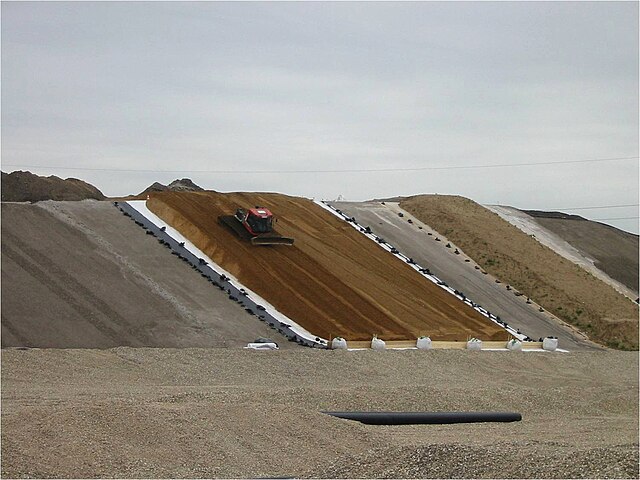Geocomposites are combinations of two or more geosynthetic materials for civil engineering applications that perform multiple geosynthetic functions, the five basic functions are: separation, reinforcement, filtration, drainage, and containment. Such composite materials may enhance technical properties of the soil or the geotechnical structure and minimize application costs.
<--1st-5th edition published by Prentice-Hall so removed self-published tag; 6th by Xlibris [self-published source]-->
Installation of a geocomposite drain. Geocomposite drains are often used on steep slopes of landfill capping systems.
Installation of a geocomposite drain.
Geosynthetics are synthetic products used to stabilize terrain. They are generally polymeric products used to solve civil engineering problems. This includes eight main product categories: geotextiles, geogrids, geonets, geomembranes, geosynthetic clay liners, geofoam, geocells and geocomposites. The polymeric nature of the products makes them suitable for use in the ground where high levels of durability are required. They can also be used in exposed applications. Geosynthetics are available in a wide range of forms and materials. These products have a wide range of applications and are currently used in many civil, geotechnical, transportation, geoenvironmental, hydraulic, and private development applications including roads, airfields, railroads, embankments, retaining structures, reservoirs, canals, dams, erosion control, sediment control, landfill liners, landfill covers, mining, aquaculture and agriculture.

Geotextile sandbags protected the historic house Kliffende on Sylt island against storms, which eroded the cliffs left and right from the sandbag barrier.
Geotextile sandbags can be approximately 20 m long, such as those used for the artificial reef at Narrow Neck, Queensland.
Geosynthetic products
Geogrids are used to prevent sliding on long and steep slopes during installation and use of a landfill capping system.

![<--1st-5th edition published by Prentice-Hall so removed self-published tag; 6th by Xlibris [self-published source]-->](https://upload.wikimedia.org/wikipedia/commons/thumb/6/63/Geocomposites1.jpg/640px-Geocomposites1.jpg)





